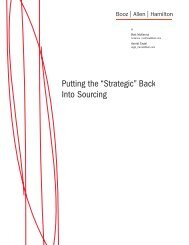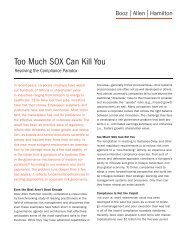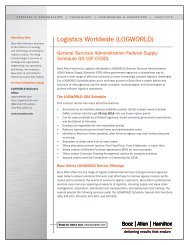Merger Integration: Delivering on the Promise - Booz Allen Hamilton
Merger Integration: Delivering on the Promise - Booz Allen Hamilton
Merger Integration: Delivering on the Promise - Booz Allen Hamilton
You also want an ePaper? Increase the reach of your titles
YUMPU automatically turns print PDFs into web optimized ePapers that Google loves.
mergers with more strategic<br />
motivati<strong>on</strong>s (e.g., move<br />
upstream or downstream in <strong>the</strong><br />
value chain, add capabilities,<br />
develop a new business model),<br />
<strong>on</strong>ly 32 percent realized <strong>the</strong>ir<br />
visi<strong>on</strong> and objectives.<br />
The widely prevalent<br />
“merger of equals” was also<br />
shown to be more failure pr<strong>on</strong>e.<br />
According to our analysis, mergers<br />
failed almost twice as often<br />
when <strong>the</strong> participants were of<br />
comparable size. Although most<br />
of <strong>the</strong> less<strong>on</strong>s in this Viewpoint<br />
are applicable to all deals, we<br />
will focus primarily <strong>on</strong> <strong>the</strong> issues<br />
attending large-scale mergers of<br />
comparably sized companies.<br />
Integrating companies is<br />
a mammoth undertaking. The<br />
tactical issues are tremendous.<br />
Indeed, when companies<br />
explained why <strong>the</strong>y had not met<br />
expectati<strong>on</strong>s, more than two<br />
thirds cited executi<strong>on</strong>-related<br />
reas<strong>on</strong>s — such as loss of key<br />
staff, poor due diligence, and<br />
delays in communicati<strong>on</strong>. Only<br />
32 percent attributed <strong>the</strong>ir failure<br />
to meet expectati<strong>on</strong>s to more<br />
strategic c<strong>on</strong>cerns such as poor<br />
fit or an overly ambitious visi<strong>on</strong>.<br />
However, whe<strong>the</strong>r tactical<br />
or strategic, problems in merger<br />
performance land <strong>on</strong> <strong>the</strong> same<br />
doorstep: <strong>the</strong>y are attributed to<br />
poor leadership. That is why so<br />
many CEOs lose <strong>the</strong>ir jobs within<br />
two years of <strong>the</strong> close of an<br />
unsuccessful large-scale merger.<br />
According to our research,<br />
am<strong>on</strong>g companies that did not<br />
achieve <strong>the</strong>ir targets, 42 percent<br />
Exhibit 2. Poor <str<strong>on</strong>g>Merger</str<strong>on</strong>g> Performance Leads to CEO Departures<br />
<str<strong>on</strong>g>Merger</str<strong>on</strong>g>s That Met Expectati<strong>on</strong>s<br />
Source: <strong>Booz</strong> • <strong>Allen</strong> & Hamilt<strong>on</strong><br />
saw <strong>the</strong> CEO depart within two<br />
years. That compares with a 16<br />
percent departure rate am<strong>on</strong>g <strong>the</strong><br />
CEOs of successful mergers (see<br />
Exhibit 2).<br />
As an executive presiding<br />
over a newly merged company,<br />
you are inundated with competing<br />
priorities and demands. But<br />
<strong>the</strong> most important questi<strong>on</strong>s<br />
before you are <strong>the</strong>se:<br />
• How do you deliver <strong>on</strong> <strong>the</strong><br />
value you promised shareholders<br />
and investors while simultaneously<br />
“keeping <strong>the</strong> wheels <strong>on</strong><br />
<strong>the</strong> business”?<br />
• In <strong>the</strong> wake of a merger, how<br />
do you successfully integrate<br />
operati<strong>on</strong>s while maintaining<br />
your focus <strong>on</strong> customers?<br />
84% CEO Remained 58%<br />
After Two Years<br />
It’s important to start <strong>the</strong><br />
merger integrati<strong>on</strong> process as so<strong>on</strong><br />
as possible. To be successful, you<br />
must sow <strong>the</strong> seeds of integrati<strong>on</strong><br />
<str<strong>on</strong>g>Merger</str<strong>on</strong>g>s That Did Not<br />
Meet Expectati<strong>on</strong>s<br />
16% CEO Departed<br />
42%<br />
within Two Years<br />
well before <strong>the</strong> deal closes. That<br />
means making <strong>the</strong> following<br />
decisi<strong>on</strong>s early:<br />
• How will we create value?<br />
• How will we approach and<br />
structure <strong>the</strong> merger?<br />
• How will we lead and manage<br />
<strong>the</strong> integrati<strong>on</strong>?<br />
• What is our people strategy<br />
for <strong>the</strong> transiti<strong>on</strong> to <strong>the</strong> merged<br />
organizati<strong>on</strong>?<br />
The unique characteristics<br />
of <strong>the</strong> deal will dictate <strong>the</strong> particular<br />
choices you make in each<br />
area; <strong>the</strong>re is no <strong>on</strong>e-size-fits-all<br />
recipe for successful merger<br />
integrati<strong>on</strong>. Comprehensive due<br />
diligence will inform <strong>the</strong>se early<br />
decisi<strong>on</strong>s, which will <strong>the</strong>n become<br />
<strong>the</strong> foundati<strong>on</strong> of a rigorous integrati<strong>on</strong><br />
planning process. The<br />
result: both organizati<strong>on</strong>s will be<br />
ready to integrate immediately<br />
after <strong>the</strong> merger’s close.<br />
3
















